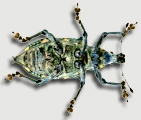Sequeira AS, Lanteri AA, Scataglini MA, Confalonieri VA, Farrell BD.
Are flightless Galapaganus weevils older than the Galapagos Islands they inhabit?. Heredity. 2000;85 (1) :20-29.
AbstractThe 15 species in the weevil genus Galapaganus Lanteri 1992 (Entiminae: Curculionidae: Coleoptera) are distributed on coastal Peru and Ecuador and include 10 flightless species endemic to the Galapagos islands. These beetles thus provide a promising system through which to investigate the patterns and processes of evolution on Darwin's archipelago. Sequences of the mtDNA locus encoding cytochrome oxidase subunit I (COI) were obtained from samples of seven species occurring in different ecological zones of the oldest south-eastern islands: San Cristobal, Espanola and Floreana, and the central island Santa Cruz. The single most parsimonious tree obtained shows two well-supported clades that correspond to the species groups previously defined by morphological characters. Based on a mtDNA clock calibrated for arthropods, the initial speciation separating the oldest species, G. galapagoensis (Linell) on the oldest island, San Cristobal, from the remaining species in the Galapagos occurred about 7.2 Ma. This estimate exceeds geological ages of the extant emerged islands, although it agrees well with molecular dating of endemic Galapagos iguanas, geckos and lizards. An apparent explanation for the disagreement between geological and molecular time-frames is that about 7 Ma there were emerged islands which subsequently disappeared under ocean waters. This hypothesis has gained support from the recent findings of Il-Myr-old submarine seamounts (sunken islands), south-east of the present location of the archipelago. Some species within the darwini group may have differentiated on the extant islands, 1-5 Ma.
